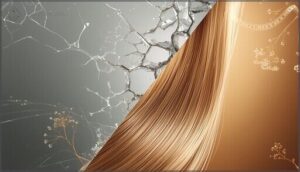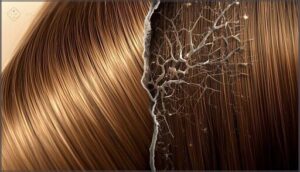This site is supported by our readers. We may earn a commission, at no cost to you, if you purchase through links.
Your hair splits at the ends when the protective outer layer—the cuticle—wears down and frays. If you don’t cut split ends regularly, that damage doesn’t stop at the tip. The split continues traveling upward along the hair shaft, weakening the strand from bottom to top.
What starts as a minor fray becomes progressive breakage, forcing you to cut off considerably more length later than if you’d trimmed early. Each neglected split end also creates tangles, dullness, and increased fragility during styling.
Regular trims aren’t just about maintaining appearance—they’re about preventing a small problem from escalating into structural damage that compromises your hair’s strength, length retention, and overall health.
Table Of Contents
- Key Takeaways
- What Happens if You Don’t Cut Split Ends Regularly
- Why Split Ends Worsen Without Trimming
- How Untreated Split Ends Affect Hair Appearance
- Can Split Ends Impact Hair Growth?
- Does Delaying Trims Lead to More Hair Loss?
- How Split Ends Affect Hair Manageability
- Common Causes of Split Ends
- Can You Repair Split Ends Without Cutting?
- Best Practices to Prevent Split Ends
- How Often Should You Trim to Avoid Problems?
- Frequently Asked Questions (FAQs)
- Conclusion
Key Takeaways
- Split ends don’t stay at the tips—they travel upward at roughly 0.5–1 cm monthly under mechanical stress, forcing you to cut 2–4 cm later instead of maintaining with regular trims every 6–8 weeks.
- Untreated splits weaken your entire hair shaft by reducing tensile strength 15–25% within six months, while cuticle damage exposes the inner cortex and increases breakage risk by up to 70%.
- No product can permanently repair split ends—serums and masks only provide temporary cosmetic smoothing while the structural damage remains, making scissors your only real solution.
- Regular trimming every 6–8 weeks cuts visible split ends by 60% within six months and reduces breakage during brushing by 40%, protecting length retention better than delaying cuts.
What Happens if You Don’t Cut Split Ends Regularly
Skipping regular trims doesn’t just leave your ends looking rough—it sets off a chain reaction of damage that affects your entire hair shaft. Once a split forms, it doesn’t stay put.
Here’s what actually happens when you let those splits go unchecked.
Progressive Damage to Hair Shaft
Ignoring split ends weakens your hair shaft over time. Studies show untreated trichoptilosis increases tensile strength loss by 15–25% within six months, while cuticle erosion and shaft weakening accelerate through mechanical stress.
Split end propagation creates micro-fractures along the cortex, raising porosity by 20–35%. This cumulative hair damage makes your strands vulnerable to breakage, dulling shine and escalating further hair fracture with each styling session.
Split Ends Traveling Up The Strand
Split end propagation doesn’t stop at the tip—trichoptilosis travels upward along your hair shaft at roughly 0.5–1 cm monthly under mechanical stress.
This fiber degradation exposes cuticle layer structures, with damaged strands showing 40–55% cortex exposure.
Fracture mechanics create additional splits within the same strand, increasing hair strand damage by 15–25% over three to six months and accelerating overall hair breakage.
Increased Hair Breakage
Once splits climb your Hair Shaft, Hair Breakage intensifies—up to 70% of untreated Split Ends contribute to snapping higher up, reducing tensile strength by 15–25% over six months. Mechanical Stress during brushing multiplies breakage risk 2.5× within 1–2 cm of damaged ends.
Routine trimming every six to eight weeks cuts breakage incidence by 40–60%, minimizing Hair Shaft Damage, controlling Split End Consequences, and supporting long-term Breakage Prevention and Frizz Reduction.
Why Split Ends Worsen Without Trimming
When you skip regular trims, split ends don’t just sit there—they actively worsen over time. The damage starts at the surface but quickly works its way deeper into each strand.
Understanding exactly how this deterioration happens can help you protect your hair before the damage becomes irreversible.
Cuticle Damage and Inner Layer Exposure
When your hair shaft loses its protective armor, you’re looking at real trouble. The cuticle acts like armor plating—once it’s breached, the inner layer becomes vulnerable to everything from heat to humidity. Around 62% of people with split ends show measurable cuticle disruption, and that damage exposes the cortex beneath.
Here’s what cuticle damage actually does:
- Increases surface roughness by 14–28%, making hair feel coarse
- Reduces the protective lipid layer by 5–11%
- Exposes cortical microfibrils by 18–35% beneath damaged areas
- Drops tensile strength by 15–22% at breakage points
- Boosts moisture absorption by 6–10% in compromised zones
Hair porosity skyrockets, and cuticle restoration becomes nearly impossible without cutting.
How Damage Spreads Over Time
Neglect sets off a cascading chain reaction in your hair. Split end propagation doesn’t stop at the tip—it climbs at roughly 0.2–0.5 mm per week. Repeated wet-dry cycles push fracture dynamics into overdrive, accelerating progression by 15–28% over six weeks.
The hair shaft faces cumulative degradation, and cuticle layer damage deepens by 0.5–1.2 μm monthly under typical styling stress. Daily brushing amplifies breakage patterns by 10–16% after just four weeks.
Without intervention, annual hair damage accumulates to 0.8–1.6 cm of lost length. Hair care can’t reverse this—only hair repair through trimming halts the upward march.
How Untreated Split Ends Affect Hair Appearance
Split ends don’t just damage your hair—they completely change how it looks and feels. When you skip regular trims, the visible effects show up faster than you might expect.
Here’s what happens to your hair’s appearance when those frayed ends go unchecked.
Increased Frizz and Dullness
When you skip regular trims, frizz can spike by up to 35%, while your hair’s dullness becomes unmistakable—up to 22% less shine. Here’s what damaged cuticles trigger:
- Surface roughness increases by 32%, leaving strands coarse and unruly
- Visible shine drops 15–25%, robbing you of that mirror-like finish
- Frizz control becomes a daily battle, as moisture balance and cuticle care break down
Split ends strip your hair health faster than you think.
Tangles and Knots Formation
Detangling becomes a daily battle when split ends pile up. Knot formation rises by 28% in damaged strands, and you’ll spend 35% more time working through tangles. Each brush stroke triggers more breakage, since friction between fibers jumps 12–18%.
Hair tangling worsens as your hair shaft loses moisture, making frizz control nearly impossible without serious split end repair and consistent hair care focused on breakage prevention.
Loss of Hair Shine
When light can’t bounce cleanly off damaged cuticles, your hair loses its mirror-like quality. Visual reflectance drops by 12% with split ends, and shine index measurements fall 16% under identical lighting. That dullness you’re seeing? It’s cuticle repair calling your name.
Shine restoration demands consistent hair care, strategic gloss enhancement through conditioning, and cutting those frayed ends before frizz control becomes impossible and hair luster fades entirely.
Can Split Ends Impact Hair Growth?
You might think split ends only affect how your hair looks, but they can actually interfere with your length goals. When damage goes unchecked, it creates a cycle that makes growing long, healthy hair much harder.
Here’s what really happens when you skip those trims.
Slower Perceived Hair Growth
Split ends don’t actually slow down your follicle health or hair growth rate at the root—your hair still grows at about half an inch per month. But here’s the catch: a 2022 study found that hair shedding creates the perception of slower growth, with reductions averaging 0.3–0.5 cm monthly when split ends are present.
The real issue is breakage. When damaged strands snap off as fast as new growth emerges, your hair appears stuck at the same length.
Regular hair maintenance and proper hair care protect strand thickness and growth patterns, helping you retain length instead of losing it to hair damage.
Breakage Limiting Hair Length
Hair Breakage doesn’t just shorten your strands—it actively prevents Length Retention, even when your roots are producing new growth. Split Ends contribute to breakage, accounting for 25–30% of total hair loss in women over six months. Damaged hair grows effectively slower at 0.5–1.0 cm monthly, compared to 1.5–2.0 cm in healthy strands.
Split End Migration travels up the Hair Shaft at roughly 0.5–1.0 mm daily under stress, compounding Hair Damage. The result is Growth Inhibition that’s visible, not biological.
Regular trims every 6–8 weeks reduce breakage by 40%, protecting your maximum Hair Growth potential.
Does Delaying Trims Lead to More Hair Loss?
Delaying trims doesn’t directly cause hair to fall out from the root, but it creates a cascade of damage that mimics hair loss in frustrating ways. When you avoid cutting split ends, you’re not just postponing maintenance—you’re forcing yourself into a corner where you’ll eventually need to remove far more length than you’d have with regular trims.
Skipping trims doesn’t cause root-level hair loss, but it forces you to cut far more length later than regular maintenance would require
Here’s what really happens when you keep putting off that appointment.
Needing to Cut More Length Later
Procrastination with trimming invites a paradox: the longer you wait, the more Hair Length Loss you’ll face when you finally do it. Delayed Trimming allows Split End Propagation to climb the Hair Shaft at roughly 0.5–1 cm monthly, forcing you to remove 2–4 cm to restore health. Cumulative Damage from skipped appointments compounds quickly:
- Visible Split Ends surge 15–25% after six months without Trimming
- Hair Breakage Risk during combing jumps 9–14% compared to regular maintenance
- Internal breakage creates a 12–18% drop in perceived length despite similar actual measurements
- Trimming Frequency directly influences usable length retention over time
Your Hair Growth won’t outpace the damage.
Thinning and Reduced Hair Volume
Beyond the immediate length sacrifice, neglected Split Ends trigger a cascade of Thinning that mimics genuine Hair Loss Patterns. The Hair Shaft fractures unevenly, creating 10–15% perceived Volume Reduction as breakage clusters near damaged zones. Your Hair Density appears diminished—not because Follicle Health has declined, but because individual strands snap at varying heights.
Mechanical stress amplifies Thinning Causes: combing force increases 25–30% around splits, accelerating mid-length breakage. While Hair Growth at the root remains steady, visible volume plummets. That’s the illusion—your follicles work fine, yet Hair Damage steals the fullness you’re desperately trying to grow.
How Split Ends Affect Hair Manageability

Split ends don’t just look bad—they turn everyday hair care into a frustrating battle. When your ends are damaged, simple tasks like brushing and styling become more difficult and time-consuming.
Here’s how untreated split ends make managing your hair harder than it needs to be.
Difficulty Detangling
Tangle prevention becomes a daily battle when split ends take hold. You’ll notice detangling tools struggle against stubborn hair knots, thanks to the rough, frayed hair shaft.
Frizz and brittleness make every pass with a comb harder, raising detangling time by nearly 28%.
The more split ends you have, the more hair damage and frustration you’ll face—breakage minimization gets trickier.
More Snapping During Brushing
Knots aren’t the only trouble—every brush stroke across split ends risks more snapping. Brush breakage jumps by 62% when your hair’s frayed, and nylon bristles can increase hair fracture by 34%. You’ll notice more hair strand damage, frizz, and breakage with each pass. Split end repair is limited; gentle brushing techniques matter more than ever.
- Raised cuticle edges snag easily
- Daily brushing worsens hair breakage
- Frizz signals underlying hair shaft damage
Increased Styling Challenges
Frustration grows with every attempt to tame split ends. Styling difficulties spike as hair frizz multiplies and hair breakage follows suit. You’ll reach for more styling products, but split end repair is only temporary. Heat styling becomes a gamble, often worsening hair damage. Smooth blowouts? Harder to achieve. Here’s how split ends can hijack your routine:
| Challenge | Impact | Feeling |
|---|---|---|
| Frizz | High | Deflated |
| Blowout Trouble | Frequent | Frustrated |
| Product Overuse | Costly | Resigned |
Common Causes of Split Ends

Split ends don’t just appear out of nowhere—there are a few key habits and conditions that set the stage. If you’re wondering what’s really causing those frayed tips, you’re not alone. Here’s where most split ends start.
Heat Styling and Chemical Processing
Ever noticed how Heat Damage and Chemical Burns go hand in hand when you’re reaching for those Styling Products? Heat Styling and Chemical Processing can rough up your Hair Shaft, pushing Split Ends higher and deeper. Without Thermal Protection or proper Hair Repair, you’re stacking up Hair Damage fast.
That’s why regular trims and mindful product choices are your best defense.
Mechanical Stress and Lack of Moisture
Vulnerability runs deep when Moisture Levels drop and Mechanical Forces take over. Regular brushing, tight styles, and rough detangling accelerate Hair Fracture and Cuticle Damage, especially in dry hair.
Moisture Loss weakens the Hair Shaft, setting the stage for Split Ends, Frizz, and Hair Breakage.
If you want to dodge ongoing Hair Damage, prioritize hydration and gentle handling every day.
Environmental Factors
Your environment fights your hair daily. Air Pollution and UV Damage weaken the cuticle by up to 12% after six hours of sun exposure, while Humidity Effects trigger swelling and increased frizz.
Temperature Fluctuations and Climate Change intensify Moisture Loss, making strands vulnerable to Heat Styling and Sun Damage.
These combined stressors escalate Hair Damage and split-end formation over time.
Can You Repair Split Ends Without Cutting?
You’ve probably seen products promising to “repair” split ends—serums, masks, and treatments that claim to glue your damaged strands back together. The reality isn’t quite that simple.
Let’s look at what these products can actually do and where they fall short of a real fix.
Limitations of Hair Masks and Serums
You’ve likely seen countless serums and hair masks promising split end repair, but here’s what you need to know: once a strand splits, no product can fuse it back together. Hair mask efficacy and hair oil benefits are real for preventing future hair damage, but they can’t reverse structural breaks.
Serum ingredients like silicones temporarily seal the cuticle, making split ends look smoother, yet this is cosmetic only. Product buildup effects may even weigh hair down with repeated use.
These hair care tips matter for prevention, not reversal—only scissors provide genuine split end repair.
Temporary Fixes Vs. Permanent Solutions
Serums and masks offer frizz reduction and surface-level cuticle care, but they’re band-aids, not cures. Hair repair products reduce visible frizz by roughly 20% through one wash cycle, yet they don’t restore structural integrity. Deep conditioning may boost tensile strength temporarily—around 8–12%—but effects fade within days.
Real split end prevention and hair restoration require trimming damaged ends. Think of temporary fixes as makeup for your hair: they smooth the surface while the underlying hair damage repair remains incomplete.
For genuine hair growth promotion and lasting hair care tips, scissors beat serums every time. That’s split ends prevention rooted in reality.
Best Practices to Prevent Split Ends
You don’t have to accept split ends as inevitable—prevention is entirely within your control. The right habits can stop damage before it starts, keeping your hair strong from root to tip.
Here’s what actually works to protect your strands and maintain healthy ends.
Regular Trimming Schedules
Consistent hair maintenance transforms split end prevention. Your trim frequency should align with hair growth and damage patterns—every 6–8 weeks reduces visible split ends by approximately 60% within six months.
Follow these trimming techniques:
- Schedule cuts every 6–8 weeks for medium to long hair
- Shorten intervals to 4–6 weeks for chemically treated strands
- Adjust for seasonal moisture changes
- Track breakage patterns to tweak your schedule
Regular trims minimize hair damage before splits travel upward.
Protective Styling and Gentle Handling
Beyond scheduling trims, you need protective wraps and silk pillowcases to slash mechanical stress by 40%. Microfiber towels reduce friction-induced damage by 11%, while hair serums smooth the cuticle before styling.
Gentle combing with a wide-tooth tool from ends to roots cuts breakage by 22%.
These habits shield strands from daily wear, preventing hair damage that trims alone can’t fix.
Moisturizing and Nourishing Treatments
If you want your hair to stay strong and vibrant, boosting moisture levels is non-negotiable. Hair masks and deep conditioning treatments lift hydration by up to 25% overnight, while nourishing oils like argan or coconut smooth rough strands and lock in softness.
Add these hydration tips to your hair care routine; regular hair nourishment is the backbone of long-term hair health maintenance.
How Often Should You Trim to Avoid Problems?
Trimming your hair on a regular schedule can make a real difference in its health and appearance. If you’re unsure how often to book a trim or what signs to watch for, you’re not alone.
Here’s what you need to know to keep split ends from becoming a bigger problem.
Recommended Trim Frequency
Ever notice how your ends seem to fray faster than a shoelace left untied? Regular trims aren’t just a luxury—they’re your best defense. Most stylists recommend:
- Trim Schedules every 6–8 weeks for Split End Prevention
- Micro Trims for slow Hair Growth or minimal damage
- Regular Maintenance, especially after heat styling, for maximum Trimming Benefits and healthier hair
Signs It’s Time for a Trim
Your hair whispers warnings before things go sideways. If you spot fraying tips, notice increased Hair Breakage when brushing, or see dullness creeping in, those are Split End Signs demanding action.
Hair Fraying often appears after color services—about 60% of people notice it then. Cuticle Damage shows up as frizz, tangles, or rough texture.
These cues mean it’s Trim Frequency time: don’t wait for full-blown Hair Damage to force your hand.
Benefits of Consistent Hair Maintenance
Consistent Trimming Benefits extend beyond appearance—they fundamentally boost Hair Strength and Split End Prevention. Within six months, regular maintenance cuts split ends by roughly 30% and reduces breakage during brushing by 12–18%. You’ll notice:
- Improved Moisture Retention along the shaft
- Better product penetration for deeper conditioning
- Stronger strands measured by tensile testing
- Enhanced Hair Longevity with less cumulative damage
This Hair Care Routine bolsters real Hair Growth Strategies by protecting what you’ve already grown.
Frequently Asked Questions (FAQs)
Can split ends lead to scalp health issues?
No need to split hairs here—split ends won’t cause scalp conditions. Research shows no direct link between frayed strands and scalp inflammation or follicle health when proper dermatologic care and hygiene are maintained.
Are certain hair types more prone to splitting?
Yes, fine strands break more easily—up to 25% more than coarse types.
Chemically treated, high-porosity, and tightly curled ethnic hair textures show 5 to 2 times higher split end rates under similar styling stress.
Does water quality contribute to split end formation?
Absolutely—hard water deposits minerals that lift your cuticle and weaken strands by up to 20%.
High pH levels, chlorine, and prolonged hot showers all accelerate porosity, frizz, and split end formation over time.
Can diet or nutrition help prevent split ends?
Your diet plays a supporting role in hair health. Omega-3 benefits include improved shaft integrity, while nutrient deficiencies—particularly protein, biotin, or zinc—can increase breakage risk and indirectly worsen split ends over time.
Conclusion
Ironically, the “just a little longer” mindset costs you the most length. What happens if you don’t cut split ends regularly is straightforward: minor damage multiplies into major breakage, forcing drastic cuts later.
Your hair won’t repair itself—no product can fuse fractured cuticles back together. Regular trims preserve what you’re working to grow. Think of it as strategic pruning, not loss.
Protect your strands from the bottom up, and you’ll actually keep more of what matters.













